Metrohm 902 User Manual
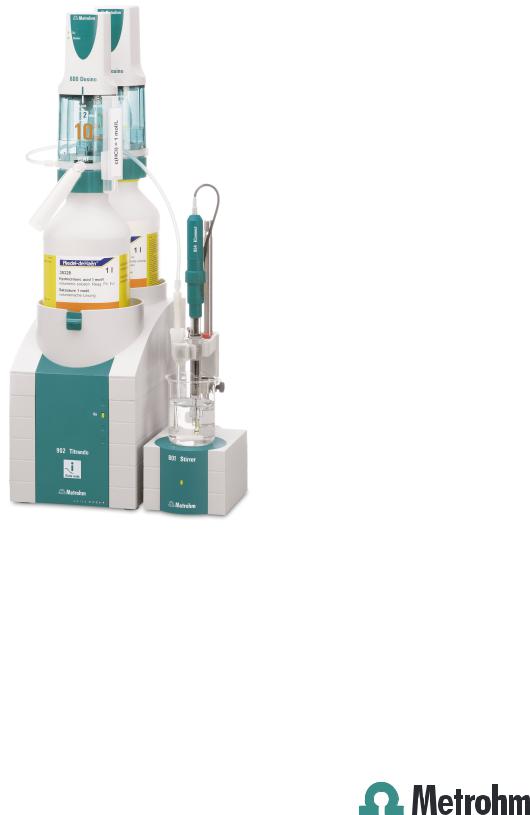
902 Titrando
Manual
8.902.8003EN / 2014-08-19

Metrohm AG CH-9100 Herisau Switzerland
Phone +41 71 353 85 85 Fax +41 71 353 89 01 info@metrohm.com www.metrohm.com
902 Titrando
Manual
8.902.8003EN / 2014-08-19 |
ek/jb |
Teachware Metrohm AG CH-9100 Herisau
teachware@metrohm.com
This documentation is protected by copyright. All rights reserved.
Although all the information given in this documentation has been checked with great care, errors cannot be entirely excluded. Should you notice any mistakes please send us your comments using the address given above.
Documentation in additional languages can be found on
http://documents.metrohm.com.
|
Table of contents |
Table of contents
1 Introduction |
1 |
||
1.1 |
|
The Titrando system ............................................................. |
1 |
1.2 |
|
Instrument description ......................................................... |
2 |
1.3 |
Titration modes – Measuring modes – Dosing com- |
|
|
|
|
mands .................................................................................... |
3 |
1.4 |
|
About the documentation ................................................... |
4 |
1.4.1 |
Symbols and conventions ........................................................ |
4 |
|
1.5 |
|
Safety instructions ................................................................ |
5 |
1.5.1 |
General notes on safety ........................................................... |
5 |
|
1.5.2 |
Electrical safety ........................................................................ |
5 |
|
1.5.3 |
Working with liquids ................................................................ |
6 |
|
1.5.4 |
Flammable solvents and chemicals ........................................... |
6 |
|
1.5.5 |
Recycling and disposal ............................................................. |
6 |
|
2 Overview of the instrument |
7 |
|
3 Installation |
|
9 |
3.1 |
Setting up the instrument .................................................... |
9 |
3.1.1 |
Packaging ................................................................................ |
9 |
3.1.2 |
Checks .................................................................................... |
9 |
3.1.3 |
Location .................................................................................. |
9 |
3.2 |
Connecting a controller ........................................................ |
9 |
3.2.1 |
Operation ................................................................................ |
9 |
3.3 |
Connecting MSB devices .................................................... |
13 |
3.3.1 |
Connecting a dosing device ................................................... |
14 |
3.3.2 |
Connecting a stirrer or titration stand .................................... |
15 |
3.3.3 |
Connecting a Remote Box ..................................................... |
16 |
3.4 |
Connecting USB devices ..................................................... |
17 |
3.4.1 |
General ................................................................................. |
17 |
3.4.2 |
Connecting a USB hub ........................................................... |
18 |
3.4.3 |
Connecting a printer .............................................................. |
18 |
3.4.4 |
Connecting a balance ............................................................ |
19 |
3.4.5 |
Connecting a PC keyboard (only for operation with Touch |
|
|
Control) ................................................................................. |
20 |
3.4.6 |
Connecting a barcode reader ................................................. |
21 |
3.5 |
Connecting sensors ............................................................ |
22 |
3.5.1 |
Connecting a pH, metal or ion-selective electrode .................. |
22 |
3.5.2 |
Connecting a reference electrode .......................................... |
23 |
3.5.3 |
Connecting a temperature sensor or an electrode with inte- |
|
|
grated temperature sensor .................................................... |
23 |
3.5.4 |
Connecting an iConnect ........................................................ |
24 |
902 Titrando |
III |
Table of contents |
|
|
|
|
3.5.5 |
Differential potentiometry ...................................................... |
25 |
4 Setting up the titration vessel |
26 |
||
|
4.1 |
General ................................................................................ |
26 |
5 |
Operation and maintenance |
27 |
|
|
5.1 |
General notes ...................................................................... |
27 |
|
5.1.1 |
Care ...................................................................................... |
27 |
|
5.1.2 Maintenance by Metrohm Service .......................................... |
27 |
|
|
5.2 |
Quality management and qualification with Metrohm . . 28 |
|
6 |
Troubleshooting |
29 |
|
|
6.1 |
General ................................................................................ |
29 |
|
6.2 |
SET titration ........................................................................ |
29 |
|
6.2.1 |
............................................................................................. |
29 |
7 |
Appendix |
|
31 |
|
7.1 |
Remote interface ................................................................ |
31 |
|
7.1.1 Pin assignment of the remote interface .................................. |
31 |
|
8 |
Technical specifications |
35 |
|
|
8.1 |
Measuring interface ........................................................... |
35 |
|
8.1.1 |
Potentiometry ........................................................................ |
35 |
|
8.1.2 |
Temperature .......................................................................... |
35 |
|
8.2 |
Power connection ............................................................... |
36 |
|
8.3 |
Safety specifications ........................................................... |
36 |
|
8.4 |
Electromagnetic compatibility (EMC) |
................................ 36 |
|
8.5 |
Ambient temperature ......................................................... |
37 |
|
8.6 |
Reference conditions .......................................................... |
37 |
|
8.7 |
Dimensions .......................................................................... |
37 |
|
8.8 |
Interfaces ............................................................................. |
37 |
9 |
Warranty (guarantee) |
39 |
|
10 Accessories |
|
41 |
|
|
Index |
|
43 |
IV |
902 Titrando |
|
Table of figures |
Table of figures |
|
|
Figure 1 |
The Titrando system .......................................................................... |
1 |
Figure 2 |
Front 902 Titrando ............................................................................ |
7 |
Figure 3 |
Rear 902 Titrando ............................................................................. |
8 |
Figure 4 |
Connecting the Touch Control ......................................................... |
10 |
Figure 5 |
Connecting the computer ................................................................ |
12 |
Figure 6 |
MSB connections ............................................................................ |
13 |
Figure 7 |
Connecting a dosing device ............................................................. |
15 |
Figure 8 |
Connecting an MSB stirrer ............................................................... |
16 |
Figure 9 |
Connecting the propeller stirrer to the titration stand ...................... |
16 |
Figure 10 |
Connecting the Remote Box ............................................................ |
17 |
Figure 11 |
Connecting a printer ....................................................................... |
19 |
Figure 12 |
Connecting a pH, metal or ion-selective electrode ........................... |
22 |
Figure 13 |
Connecting a reference electrode .................................................... |
23 |
Figure 14 |
Connecting a temperature sensor or an electrode with integrated tem- |
|
|
perature sensor ............................................................................... |
23 |
Figure 15 |
Connecting the iConnect ................................................................. |
24 |
Figure 16 |
Connecting an electrode to the iConnect ........................................ |
25 |
Figure 17 |
Schematic configuration of magnetic stirrer, electrode and buret tip |
|
|
during a titration. a) stirring direction clockwise, b) stirring direction |
|
|
counterclockwise. ........................................................................... |
26 |
Figure 18 |
Connectors of the Remote Box ........................................................ |
31 |
Figure 19 |
Pin assignment of remote socket and remote plug .......................... |
31 |
902 Titrando |
V |
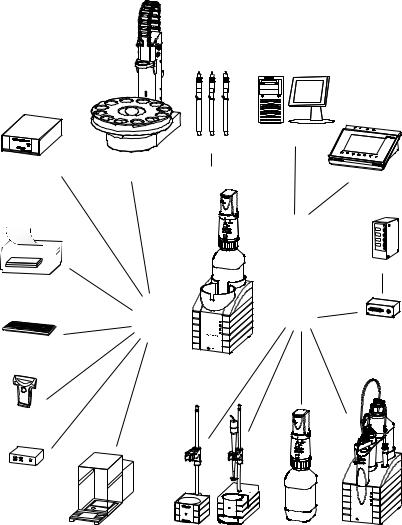
|
1 Introduction |
1 Introduction
1.1The Titrando system
The Titrando is the heart of the modular Titrando system. Operation is carried out either by Touch Control with a touch-sensitive screen ("standalone titrator") or by a computer with a corresponding software.
A Titrando system can contain numerous kinds of a variety of instruments. The following figure provides an overview of the peripheral devices you can connect to the 902 Titrando.
Dosing Interface
Printer
PC keyboard
Barcode
reader
USB hub
Figure 1
|
|
|
Computer |
|
|
Sensors |
|
USB Sample Processor |
|
|
|
Robotic Titrosampler |
Input 1 / 2 |
Touch Control |
|
|
|
||
|
|
|
Controller |
|
|
|
Relay Box |
|
USB |
|
MSB |
|
|
|
Remote Box |
|
Converter |
Titrando |
|
|
|
|
|
|
232 |
|
|
USB/RS |
- |
|
|
|
|
|
|
|
|
|
8mDi50soa |
|
|
|
Mrothe |
Balance |
Stirrer / Ti Stand |
Dosino |
Dosimat |
The Titrando system
902 Titrando |
1 |
1.2 Instrument description |
|
Up to three control instruments (Titrando, Dosing Interface, USB Sample Processor, etc.) can be controlled via USB connection during operation with the 900 Touch Control.
You can request information on special applications in the "Application Bulletins" and "Application Notes", available free of charge through the responsible Metrohm representative. Various monographs on the subjects of titration techniques and electrodes are also available.
Updating the device software is described in the Help for the corresponding PC software.
1.2Instrument description
The 902 Titrando has the following characteristics:
Operation
Operation is carried out by means of a touch-sensitive Touch Control or with high-performance PC software.
MSB connectors
Four MSB connectors (Metrohm Serial Bus) for connecting dosing devices (Dosimat with exchange unit or Dosino with dosing unit), stirrers, titration stands and Remote Boxes.
USB connectors
Two USB connectors, through which devices such as printers, PC keyboards, barcode readers or additional control instruments (USB Sample Processor, Titrando, Dosing Interface, etc.) can be connected.
Measuring interface
One measuring input each for:
–a potentiometric electrode (pH, metal or ion-selective electrode)
–a separate reference electrode
–a temperature sensor (Pt1000 or NTC)
–an iConnect (measuring interface for electrodes with integrated data chip, so-called iTrodes)
2 |
902 Titrando |
|
1 Introduction |
1.3Titration modes – Measuring modes – Dosing commands
The 902 Titrando supports the following titration modes, measuring modes and dosing commands:
SET
Endpoint titration at one or two specified endpoints. Measuring modes:
–pH (pH measurement)
–U (potentiometric voltage measurement)
STAT
Endpoint titration during which the measured value is kept constant. Measuring modes:
–pH (pH measurement)
–U (potentiometric voltage measurement)
MEAS
The following measuring modes can be selected for measurements:
–pH (pH measurement)
–U (potentiometric voltage measurement)
–T (temperature measurement)
CAL
Electrode calibration. Measuring mode:
–pH (calibration of pH electrodes)
ELT
Electrode test for pH electrodes.
This mode is listed separately only in tiamo™. In Touch Control, the electrode test is a component part of the CAL calibration mode.
Dosing commands
The following commands for dosing can be selected:
–PREP (rinsing the cylinder and tubings of an exchange unit or dosing unit)
–EMPTY (emptying the cylinder and tubings of a dosing unit)
–ADD (dosing a specified volume)
–LQH (carrying out complex dosing tasks with a Dosino)
902 Titrando |
3 |
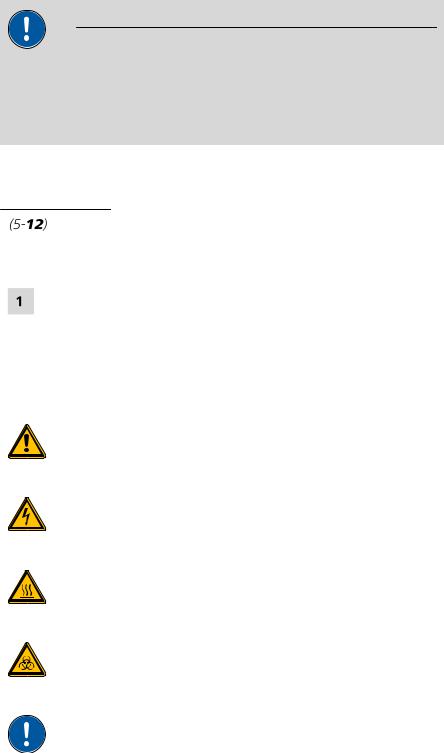
1.4 About the documentation |
|
1.4About the documentation
CAUTION
Please read through this documentation carefully before putting the instrument into operation. The documentation contains information and warnings which the user must follow in order to ensure safe operation of the instrument.
1.4.1Symbols and conventions
The following symbols and formatting may appear in this documentation:
|
Cross-reference to figure legend |
|
The first number refers to the figure number, the sec- |
|
ond to the instrument part in the figure. |
|
|
|
Instruction step |
|
Carry out these steps in the sequence shown. |
|
|
Method |
Dialog text, parameter in the software |
|
|
File New |
Menu or menu item |
|
|
[Next] |
Button or key |
|
|
|
WARNING |
|
This symbol draws attention to a possible life-threat- |
|
ening hazard or risk of injury. |
|
|
|
WARNING |
|
This symbol draws attention to a possible hazard due |
|
to electrical current. |
|
|
|
WARNING |
|
This symbol draws attention to a possible hazard due |
|
to heat or hot instrument parts. |
|
|
|
WARNING |
|
This symbol draws attention to a possible biological |
|
hazard. |
|
|
|
CAUTION |
|
This symbol draws attention to possible damage to |
|
instruments or instrument parts. |
|
|
4 |
902 Titrando |
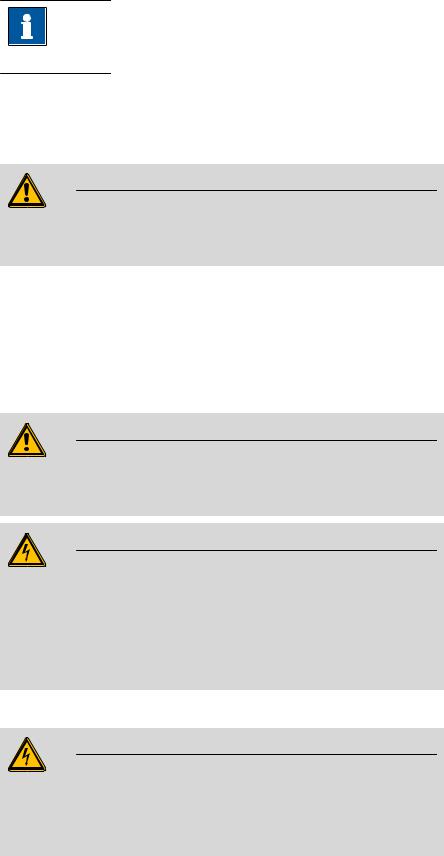
|
1 Introduction |
NOTE
This symbol highlights additional information and tips.
1.5Safety instructions
1.5.1General notes on safety
WARNING
This instrument may only be operated in accordance with the specifications in this documentation.
This instrument has left the factory in a flawless state in terms of technical safety. To maintain this state and ensure non-hazardous operation of the instrument, the following instructions must be observed carefully.
1.5.2Electrical safety
The electrical safety when working with the instrument is ensured as part of the international standard IEC 61010.
WARNING
Only personnel qualified by Metrohm are authorized to carry out service work on electronic components.
WARNING
Never open the housing of the instrument. The instrument could be damaged by this. There is also a risk of serious injury if live components are touched.
There are no parts inside the housing which can be serviced or replaced by the user.
Mains voltage
WARNING
An incorrect mains voltage can damage the instrument.
Only operate this instrument with a mains voltage specified for it (see rear panel of the instrument).
902 Titrando |
5 |

1.5 Safety instructions |
|
Protection against electrostatic charges
WARNING
Electronic components are sensitive to electrostatic charges and can be destroyed by discharges.
Do not fail to pull the mains cable out of the mains connection socket before you set up or disconnect electrical plug connections at the rear of the instrument.
1.5.3Working with liquids
CAUTION
Periodically check all system connections for leaks. Observe the relevant regulations in respect to working with flammable and/or toxic fluids and their disposal.
1.5.4Flammable solvents and chemicals
WARNING
All relevant safety measures are to be observed when working with flammable solvents and chemicals.
Set up the instrument in a well-ventilated location (e.g. fume cupboard).
Keep all sources of flame far from the workplace.
Clean up spilled liquids and solids immediately.
Follow the safety instructions of the chemical manufacturer.
1.5.5Recycling and disposal
This product is covered by European Directive 2002/96/EC, WEEE – Waste from Electrical and Electronic Equipment.
The correct disposal of your old equipment will help to prevent negative effects on the environment and public health.
More details about the disposal of your old equipment can be obtained from your local authorities, from waste disposal companies or from your local dealer.
6 |
902 Titrando |
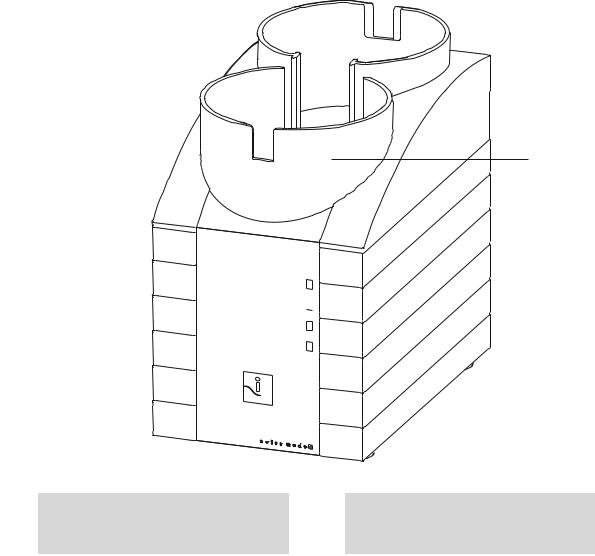
|
2 Overview of the instrument |
2 Overview of the instrument
On 

1
2
902 Titrando
iTrode ready



 Metrohm
Metrohm
Figure 2 Front 902 Titrando
1Bottle holder
With holding clamps, for two reagent bottles.
2"On" LED
Lights up when the Titrando is ready for operation.
902 Titrando |
7 |
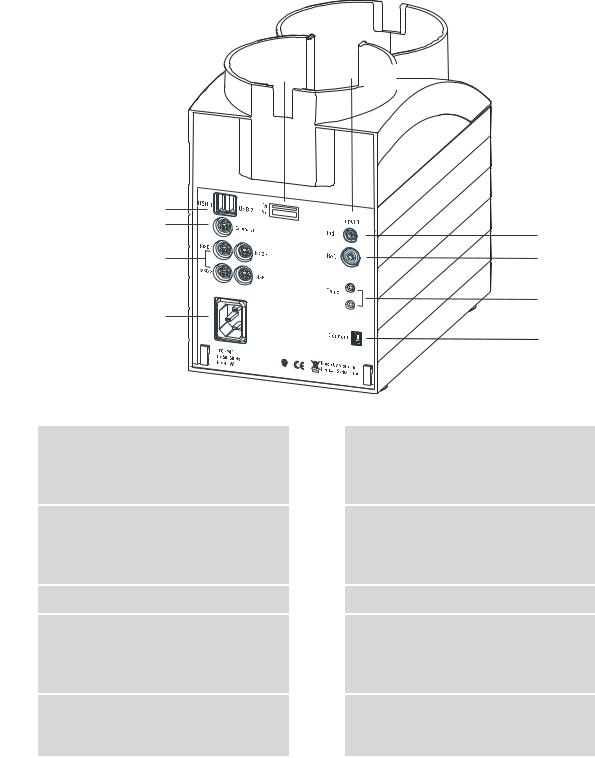
1 6 

2 |
|
|
3 |
|
7 |
|
|
|
4 |
|
8 |
|
|
9 |
5 |
|
|
|
|
10 |
Figure 3 Rear 902 Titrando |
|
|
1 Type plate |
2 |
USB connector (USB 1 and USB 2) |
Contains specifications concerning supply |
|
USB ports (type A) for connecting printer, |
voltage, instrument type and serial number. |
|
keyboard, barcode reader, additional Titran- |
|
|
dos, USB Sample Processor, etc. |
3Connector (Controller)
For connecting a Touch Control or a PC with installed PC software. Mini DIN, 9-pin.
4MSB connector (MSB 1 to MSB 4)
Metrohm Serial Bus. For connecting external dosing devices, stirrers or Remote Boxes. Mini DIN, 9-pin.
5Power socket
7Electrode connector (Ind.)
For connecting pH, metal or ion-selective electrodes with integrated or separated reference electrode. Socket F.
9Temperature sensor connector (Temp.)
For connecting temperature sensors (Pt1000 or NTC). Two B sockets, 2 mm.
6Measuring interface 1 (Input 1)
8Electrode connector (Ref.)
For connecting reference electrodes, e.g. Ag/AgCl reference electrode. Socket B, 4 mm.
10Electrode connector (iConnect)
For connecting electrodes with integrated data chip (iTrodes).
8 |
902 Titrando |
